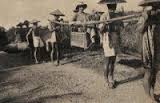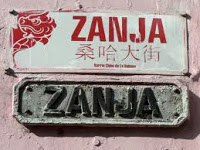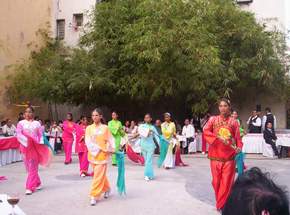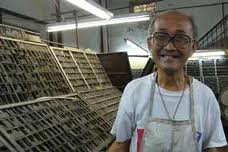LARGA HISTORIA de la Comunidad China en Cuba
Una de las formas que los inmigrantes han empleado en todos los tiempos y en todos los lugares es la unión voluntaria en grupos con nexos de afiliación que les permite enfrentar las duras condiciones de vida que les impone residir en medios diferentes al de origen.
La inmigración China de Cuba es la comunidad más destacada y la más numerosa de asiáticos asentados en la isla, llegaron a Cuba antes de la independencia de la república y fueron vendidos como esclavos por contrabandistas inescrupulosos que los reclutaban con contratos engañosos en Manila, para supuestamente trabajar en los campos de caña como obreros libres, pero en realidad el tal contrato no era otra cosa que un papel sin valor legal alguno para el infeliz asiático que sería utilizado como mano de obra forzosa y barata en competencia con los negros esclavos. De ahí viene la popular frase cubana de “Te engañaron como a un chino”.
Pero antes de continuar vale la pena aclarar que era una contrata. Mediante este documento, un chino era prácticamente capturado y encerrado hasta que un barco muy parecido a los negreros, lo conducía a la Isla de Cuba. El documento que permitía el engaño estaba redactado en español y chino, (la mayoría de las veces el infortunado no sabía leer ni escribir), y se le hacia declarar al infeliz:
“… me conformo con el salario estipulado, aunque se y me consta es mucho mayor el que ganan otros jornaleros libres y esclavos de la Isla de Cuba, porque esta diferencia la juzgo compensada con las otras ventajas que ha de proporcionarme mi patrono…”
Realmente, el chino llegaba endeudado a la isla, y cada año esa deuda crecía mas, además de ser maltratado con el látigo y el cepo, al igual que los esclavos.
Han transcurrido 165 años de la migración de los chinos a Cuba, estos venían bajo la máscara de colonos contratados para sustituir la mano de obra esclava africana en momentos en comenzaba a decaer esta mano de obra barata.
Los chinos de Cuba no quedaron ajenos a esta necesidad y casi desde el mismo tiempo en que los primeros lograron liberarse de su contrata surgen las primeras uniones, inicialmente como un medio de sostenerse mutuamente y como un recurso de resistencia para defender al mismo tiempo sus intereses de grupo y sus derechos.
Las sociedades chinas imitaron, en cierta medida, las estructuras clasistas y sociales de la lejana patria, y por ello fue natural que tendieran a preservar sus tradiciones y elementos socioculturales, aunque es ineludible la influencia de la cultura nativa lo que provoca en alguna medida transformaciones desde el punto sociocultural.
Inicialmente las sociedades eran estrictamente para los naturales y sus hijos “legítimos”, es decir aquellos que hablaban el idioma y eran de primera generación.
Con el paso de los años, ante la inevitable merma en la inmigración, así como el resultado de diferentes re-emigraciones, los requisitos comenzaron a perder su rigidez y fueron aceptados descendientes de otras generaciones.
Esta es una característica de las sociedades chinas de Cuba, cuya Comunidad está formada principalmente por descendientes
El legado que comienzan a aportar los chinos al proceso de formación de nuestro pueblo desde 1847 es difícilmente resumible en escasas cuartillas, de todas formas lo que primero solo fueron influencias, ahora se denotan rasgos de la identidad cultural.
Desarrollo
Cuando miles de chinos en su mayoría de la provincia de Guangdong, que llegaron para “mezclar su sangre con la de los cubanos y así, junto a los españoles y africanos, conformar las raíces de la nacionalidad cubana”, traídos a Cuba en condiciones de servidumbre como trabajadores brutalmente explotados, se sumaron a la guerra revolucionaria para abolir la esclavitud e independizarse del dominio colonial español.
Los chinos se fueron a la manigua a combatir junto a los Mambises contra el poderío colonial español. Las palabras famosas del general Gonzalo de Quesada, uno de los dirigentes de la guerra cubana de independencia de 1895, de que “no hubo un chino cubano desertor, no hubo un chino cubano traidor”. En el monumento de Línea en honor a los chinos que pelearon por la independencia de Cuba aparece:
“Nunca hubo un chino traidor”.
Si bien está creciendo en Cuba el interés en la cultura y las artes que los inmigrantes chinos trajeron a la isla, así como el orgullo en esta rica historia, el mundialmente célebre barrio chino de La Habana, antes el más grande de América Latina, ya no se parece a lo que era antes.
Los chinos en Cuba se han agrupado en varios tipos de asociaciones: territoriales, corporativas, políticas, de ayuda mutua y patronímica. Las primeras fueron La Unión (Kit Yi Tong), y Los Hermanos ((Heng Yi Tong), que datan de 1867 y 1868 respectivamente.
Las sociedades territoriales agrupan a los nacidos en la misma región o aldea. Las corporativas a propietarios con fines de mutua protección ante la competencia. Las sociedades patronímicas son instituciones tradicionales basadas en la organización clánica por vía patrilineal característica de la aldea china.
Su principio es la asociación derivada de la familia extendida y agrupa a los chinos que se definen como descendientes de un antepasado común. Todavía existen en Cuba diez de estas:
Yi Fung Toy Tong (apellido Yi) On Ten Tong (apellidos Bu, León, Cheng y Hung) Wong Kon Ja Tong (apellido Wong) Jong Sai Li (apellido Li) Lung Con Cun Sol (apellidos Lau, Kuang, Chiong, y Chiu) Chi Tack Tong (apellidos Eng, Chao, Choi y Yun) Soy Jo Jon (apellido Lam) Sue Yu Tong (apellido lui, Kong y Fong) Chang Weng Chung Tong (apellido Chang) Chang Luen Kong Sol (apellidos Jan, Joy y Chie).
La Wong Kong Ja Chi Chi Sol, nombre por el que va a ser bautizado en un inicio esta asociación, se crea exactamente en Mayo del 1914 por el ciudadano chino Wong Cheng Wo, quien según cuentan los miembros actuales de la institución, ocupó importantes cargos en las Juntas Directivas de algunas sociedades ya fundadas, fungiendo también como administrador de extinto periódico chino “WAH MAN SION PO”.
Desde su arribo a Cuba, y junto a algunos paisanos, habían hecho algunos intentos por crear una especie de grupo en el que se congregara a los chinos descendientes del apellido Wong que, según refieren algunas fuentes, constituían un número significativo.
De acuerdo a los diferentes tipos de sociedades que se crearon, esta asociación responde a los patrones de una sociedad clónica o patronímica, en la que el apellido paterno constituye el principal nexo de afiliación entre sus socios. A diferencia de muchas, como por ejemplo la Lung Kong (que agrupa en su seno a los miembros de 4 familias, “la Wong”- nombre por el que afectuosamente es conocida por todos – solo va agrupar a los apellidados por Wong.
Además, y respondiendo a otra tipicidad de las de tipo patrilineal, los lazos de hermandad descansan sobre el culto y la veneración a una figura generalmente de la historia o la leyenda china, que en este caso corresponden a Wong Xi Quiong.
Como casi todos las sociedades chinas creadas en La Habana y en el resto del país, la manutención de fondos estaban respaldados por donaciones y el pago de las cuotas mensuales de sus asociados, lo que no le dio la posibilidad desde un inicio de contar con una sede propia, obligados en el mayor de los casos a rentar algunos inmuebles para sesionar. En la medida en que creció la membresía o la situación económica les permitió, pudieron adquirir un inmueble propio.
El reglamento es uno de los documentos más importantes que emite cualquier institución dentro de la sociedad, pues es el encargado de darle el verdadero sentido de miembros activos a toda institución en el medio en el que se desarrolla. Además, en él se recoge todas las características que la hacen única y específica.
En la primera carta reglamentaria perteneciente a la Wong, y según los miembros actuales de la dirección de la institución, quedó establecida la conformación de una Junta Directiva compuesta por los cargos tradicionales: Presidente, Vice-presidente, Secretario y Tesorero.
De igual forma, un elemento a resaltar fueron los requisitos necesarios para la incorporación a la sociedad, en el que se estipuló de manera inviolable ser chino natural o descendiente, así como tener el apellido Wong. De esta manera se ratifican los objetivos de su existencia como grupo: reafirmarse como una etnia.
Con el transcurso de los años, el trabajo de la sociedad iba en ascenso, siempre dirigido a lograr una mejor atención para con sus asociados, logrando reunir, según cuentan algunos, con cerca de 1600 miembros.
La culminación en el año 1929, de la construcción del panteón de la sociedad en el Cementerio Chino va a ser el antecedente de un conjunto de acciones que la dirección va a desplegar y que van a tener su cristalización en el año 1944 cuando, con Hin Sun, Chock Cham, Chiok Jun, Tan Lap, Chou Kion, Wang Yut, Tung Fan y otros, se crea un Frente Especial de Colaboración Benéfica de la sociedad WONG KONG JA TONG.
La creación de este frente tenía como objetivo primordial brindar medicamentos a enfermos, ayuda económica a miembros desamparados, darle un tratamiento decoroso en caso de fallecimiento así como ofrecer una atención esmerada a todos sus congregados en general. Esta creación bajo la tutela de la Junta Directiva constituyó un acicate para que muchos chinos y descendientes se sintieran atraídos por el trabajo que se estaba desarrollando y decidieran pertenecer a la sociedad.
La sociedad China Wong Kong Ja Tong es una sociedad patronímica que agrupa a chinos naturales y descendientes de apellido Wong, su razón social es ser una Institución de Instrucción y Recreo, manteniendo el acerbo cultural y atención de ayuda a sus socios.
Se hará referencia algunos de los valerosos chinos, o descendientes con apellido Wong que han aportado valientemente sus acciones a la revolución cubana sin importarle el precio a cobrar; su vida.
En la comunidad china en Cuba existían cuatro periódicos impresos, que se editaban tres en el barrio chino y uno en Santiago de Cuba, el de mayor circulación era el de Wah Man Sion Po ( Hua Mín Sheng Bào)
Siendo su director el señor Wong Chong Wod (Huáng Chong hé), dedicado principalmente a ofrecer informaciones mercantiles y crónicas de las sociedades chinas. Radicaba en la calle Amistad No. 420, en la planta baja del Casino Chong Wah.
En la década del 40 al 50 existían 3 emisoras habaneras, donde salían al aire música de la opera cantonesa y un noticiero radiofónico de 30 minutos, transmitiendo en la lengua Guangdogdesa (cantonesa), por los locutores chinos Guillermo Wong (Huáng Yúnqí) y Angel Hunjan (Wù Zhuozhang), el primero salía por la emisora CMCK y era patrocinado por la compañía Sabatés anunciando el jabón Llave y el segundo por la COCO que anunciaba el jabón Candado de Crusellas y Compañía.
El señor Wong representaba la política del Guómíndang y el señor Hunjan Zhigongdang, los cuales transmitían las noticias y comentarios relacionados con el conflicto bélico, sin señalar la corrupción y la traición del gobierno de Jiang Jieshe, y así como las crónicas y notas sobre las actividades en las que se agrupaban los paisanos en frecuentes ocasiones para escucharlos.
Conclusiones
Para siempre han quedado aquí los monosílabos y sonoros apellidos, los ojos rasgados y ágiles llegados con esta migración que ha venido a entregar una cara más al prisma de nuestra nacionalidad. Sin embargo, la esencia última de estos hombres sigue siendo un misterio, velado por una cortina tenue pero infranqueable, hecha de aromático humo de sándalo. Algo hay, más allá, que los chinos siempre reservan, como el preciado tesoro de su identidad. Algo existe, milenario y muy asiático, que han sabido guardar con celo incorruptible.
El barrio chino de La Habana, vive todavía el enigma, guardado en el corazón de unos emigrantes sin retorno, nuestros hermanos durante tantos años. Antes, decir “Tienes a un chino atrás” significaba que te habías puesto fatal. Que la suerte te había abandonado. Algo así como una desgracia detrás de la otra. Pero los tiempos han cambiado.
Hoy tener un “Chino atrás” representa todo lo contrario porque la China de ahora es toda una potencia mundial. Aquel gigante dormido del que nos hablara Napoleón Bonaparte al decir:
“No lo despierten que cuando se levante del sueño, seremos nosotros los que no podremos dormir”.
Monografias/Mercedes Lina Wong Torres/Excerpts/Internetphotos/thecubanhistory.com
THE CHINESE COMMUNITY IN CUBA HISTORY.
The CUban History, Hollywood.
Arnoldo Varona, Editor
Malecón de La Habana. Por la avenida del puerto, Cuba
FOTO por Cecilia Habanera — with Manuel Otero, Claudia Rosales and Pilar Mercedes Gomez Gomez.
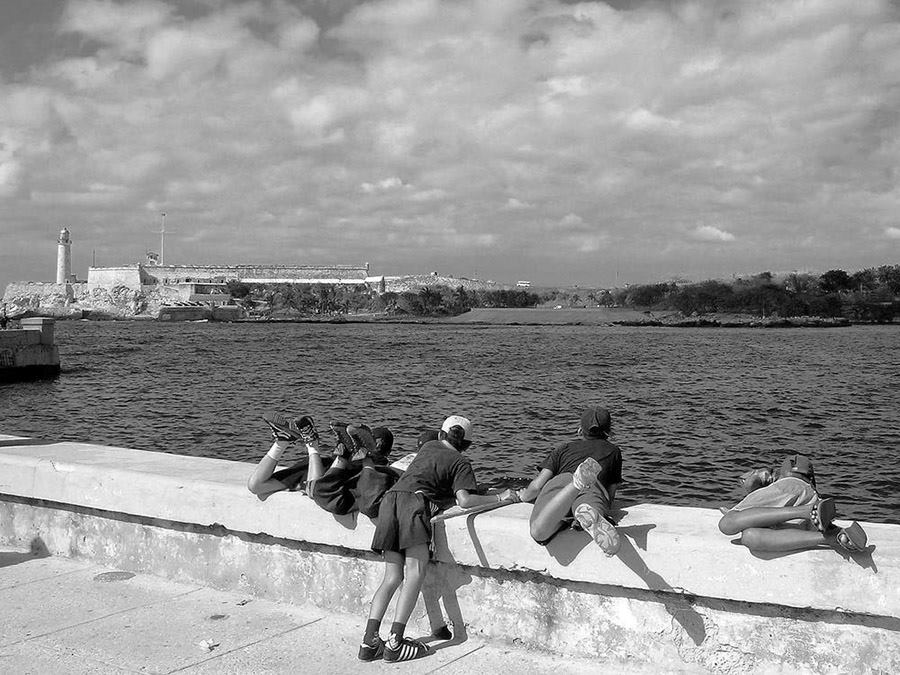
LONG HISTORY Chinese Community in Cuba.
One of the ways that immigrants have been employed in all times and in all places is the voluntary union membership groups with links enabling them to face the harsh conditions of life imposed on them reside in different media at home .
Chinese immigration to Cuba is the most prominent and the largest community of Asians settled in the island, came to Cuba before the independence of the republic and were sold into slavery by unscrupulous smugglers who recruited them with misleading contracts in Manila, for allegedly work in the cane fields as free workers, but in fact such a contract was nothing more than a paper without any legal value for the Asian unhappy that would be used as forced labor and cheap labor in competition with the black slaves . Hence the popular Cuban phrase ” You cheated as a Chinese ” .
But before continuing it’s worth noting that it was a contract . Through this document , a Chinese was almost caught and locked up until a lot like the slave ship, leading to the Island of Cuba . The document that allowed the deception was written in Spanish and Chinese , (most of the time the unfortunate could not read or write ) , and was unhappy to declare :
” … I am content with the salary stipulated , though and I know that is much larger gain other free laborers and slaves of the island of Cuba , the judge because this difference offset the other benefits that my employer has to provide me . .. ”
Actually, the Chinese came to the island in debt , and every year the debt grew more in addition to suffer affliction with the whip and the stocks , like slaves .
164 years of Chinese migration to Cuba have passed , they came under the mask of settlers hired to replace the hand of African slave labor at times began to fade this cheap labor .
The Chinese in Cuba were not oblivious to this need and almost from the time the first managed to break free from their first marriages contracted arise initially as a means of mutual support and as a source of resistance to defend their interests while group and their rights.
Chinese companies mimicked , to some extent, class, and social structures of the distant homeland , and so it was natural that tended to preserve their traditions and cultural elements , but is inescapable influence of native culture which causes changes in some measure from the sociocultural point .
Initially companies were strictly for natural and ” legitimate” children , ie those who spoke the language and were first generation.
Over the years, before the inevitable decline in immigration, and the results of different re- emigration , requirements began to lose its rigidity and were accepted descendants of other generations.
This is a feature of Chinese companies Cuba , whose community consists mainly of descendants
The legacy that the Chinese are beginning to bring to the training of our people since 1847 is hardly epitomized by limited pages , anyway what influences were first only now features of cultural identity are denoted .
Development
When thousands of mostly Chinese province of Guangdong , who came to “mix their blood with that of the Cubans and so, with the Spanish and African , forming the roots of Cuban nationality ” , brought to Cuba in condition bondage and brutally exploited workers , joined the revolutionary war to abolish slavery and independence from Spanish colonial rule.
The Chinese went to the bush to fight alongside the Mambises against Spanish colonial rule . The famous words of General Gonzalo de Quesada , one of the leaders of the Cuban War of Independence of 1895 , that ” there was no Chinese Cuban defector , there was a Cuban Chinese traitor.” In the Line monument honoring the Chinese who fought for the independence of Cuba appears :
” There was never a Chinese traitor .”
While it is growing in Cuba ‘s interest in culture and the arts that Chinese immigrants brought to the island as well as pride in this rich history , world famous before the largest Chinatown in Havana , Latin America, and not like it was before .
The Chinese in Cuba are grouped into several types of associations : regional , corporate , political, mutual aid and patronymic . The first were The Union (Kit Tong Yi ) and The Brothers ( ( Heng Tong Yi ) , dating from 1867 and 1868 respectively.
The territorial societies grouped those born in the same region or village. The corporate owners for mutual protection against competition. The patronymic societies are traditional institutions based on patrilineal clan organization by feature via Chinese village.
Its principle is association arising from the extended family and the Chinese groups are defined as descendants of a common ancestor. Cuba still exist in ten of these :
Fung Toy Tong Yi ( Yi name ) On Ten Tong (surname Bu, Leon, Cheng and Hung ) Wong Kon Ja Tong ( surname Wong ) Sai Jong Li ( surname Li) Lung With Cun Sun (surname Lau, Kuang , Chiong , and Chiu ) Tack Tong Chi (surname Eng, Chao, Choi and Yun ) ‘m Jo Jon ( surname Lam ) Sue Yu Tong ( lui surname, Fong Kong ) Chung Tong Weng Chang ( surname Chang ) Luen Chang Sun Kong (surname Jan, Joy and Chie ) .
The Wong Kong Ja Chi Chi Sun , the name by which it is to be baptized in the beginning this partnership is created exactly in May 1914 by the Chinese national Wong Cheng Wo , who as have the current members of the institution, held important positions on the boards of some companies already founded , also serving as manager late Chinese newspaper ” SION PO WAH MAN ” .
Since arriving in Cuba , and with some countrymen , had made some attempts to create a kind of group in which the descendants of Wong Chinese name , according to some sources refer constituted a significant number are congregated .
According to the different types of companies that were created , this association responds to a clonal patterns patronymic or society , in which the last name is the main link between its affiliate partners. Unlike many , such as Lung Kong ( which brings into its ranks members of 4 families, ” Wong ” – the name by which he is affectionately known to all – just going by grouping surnamed Wong .
Furthermore, responding to other criminality of the type of patrilineal , the bonds of brotherhood rest on worship and veneration to a generally figure in the history or Chinese legend, which in this case correspond to Xi Quiong Wong .
Like most Chinese companies created in Havana and the rest of the country , maintenance of funds were supported by donations and payment of monthly dues of its members , which gave him no chance from the beginning to have a own seat , forced the biggest cases to rent some property for meetings . To the extent that the membership grew and the economic situation allowed them , they could buy their own property.
The regulation is one of the most important documents issued by any institution in society , it is responsible for giving the true sense of active members of any institution in the environment in which it operates. In addition, he has all the characteristics that make it unique and specific.
In the first letter pertaining to regulatory Wong, and according to the current members of the management of the institution , was established the formation of a Board of Directors composed of the traditional positions: Vice – President , Secretary and Treasurer President .
Similarly, an item to highlight were the requirements for joining the society , which was stipulated to be inviolable natural way Chinese or descendant, as well as having the surname Wong . Thus the objectives of their existence as a group are ratified : reassert itself as an ethnic group .
Over the years, the work of the society was rising , always aimed at achieving better care for their partners , bringing together , as some have , with about 1600 members.
The completion in 1929 , construction of the pantheon of the company in the Chinese Cemetery will be the history of a set of actions that management will deploy and will have its crystallization in 1944 when Hin Sun , Chock Cham, Chiok Jun, Tan Lap , Kion Chou , Wang Yut Tung Fan and others, a Special Front Charitable Collaboration JA KONG WONG TONG society is created.
The creation of this front was intended to mainly provide medication to patients , financial assistance to homeless members, give a decent treatment in case of death as well as offering a careful attention to all your assembled in general. This creation under the guidance of the Board constituted an incentive for many Chinese descendants and were attracted by the work was proceeding and decided to belong to the society.
China Society Kong Ja Tong Wong is a patronymic company comprising natural Chinese and descendants surnamed Wong, its name is to be an institution of Instruction and Recreation , keeping the cultural wealth and care helps its partners.
Reference will brave some Chinese , or descendants with surname Wong who bravely contributed their shares to the Cuban revolution no matter what price to charge , his life .
In the Chinese community in Cuba there were four print newspapers , which were edited three Chinatown and one in Santiago de Cuba , the largest circulation was Sion Man Wah Po ( Lo Sheng Hua Bào )
As its director Mr. Wong Chong Wod ( Huáng Chong hé ), mainly dedicated to providing commercial information and reports of Chinese companies . Lay in the street Friendship No. 420 , on the ground floor of Chong Wah Casino .
In the 40 to 50 were three stations Havana , where they became available Cantonese opera music and a radio news program 30 minutes broadcast in Guangdogdesa language ( Cantonese ) , Chinese speakers by William Wong ( Huáng Yunqi ) and Angel Hunjan (Wu Zhuozhang ) , the first CMCK walked out the station and was sponsored by the company announcing Sabatés soap Key and the second by COCO announcing the padlock company Crusellas and soap.
Mr. Wong represented the Kuomintang policy and Mr. Hunjan Zhi Gong Dang , which transmitted news and reviews related to the war, without noting the corruption and betrayal Jiang Jieshe government , and as well as chronic and notes on activities in which the peasants were grouped on frequent occasions to listen .
Conclusions
To have always been here and sound monosyllabic surnames, slanted eyes and nimble arrived this migration has come to deliver a more face the prism of our nationality . However, the ultimate essence of these men remains a mystery , veiled by a thin but impenetrable curtain , made of aromatic smoke of sandalwood. There is something beyond which the Chinese always reserved as the precious treasure of his identity. Something exists , ancient and very Asian , who have managed to keep heat imperishable .
Chinatown in Havana, still living enigma , guarded in the heart of a non-return migrants , our brothers for many years. Before you say ” Have a Chinese back ” meant you had put fatal. May the luck you had left . Something like a misfortune after another . But times have changed.
Today having a ” Chinese back ” represents the opposite because China now is a real world power. Sleeping giant that we speak of Napoleon Bonaparte to say :
“I do not wake up that when sleep is we who can not sleep.”
Monographs / Mercedes Torres Lina Wong / Excerpts / Internetphotos / thecubanhistory.com
THE CHINESE COMMUNITY IN HISTORY CUBA .
The Cuban History , Hollywood.
Arnoldo Varona , Editor




